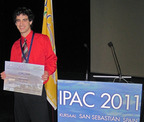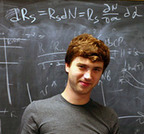SRF News: 2011
Cornell-ERL Main-Linac Cavity Reaches Performance Specs in Vertical Test (10/15)

At left: Plot of Quality Factor versus Accelerating Gradient at 1.8 K. The star marks the ERL main linac quality factor and accelerating gradient design specification. At right: Cornell's 7-cell superconducting RF cavity (click image for enlarged view).
Cornell SRF Graduate Student Receives Poster Award (09/13)

Cornell Graduate student Sam Posen at International Particle Accelerator Conference 2011 in San Sebastian, Spain.
His poster presents his work on Nb3Sn as an alternative superconductor for accelerating cavity applications. A defect-free cavity coated by Nb3Sn has the potential to achieve nearly twice the accelerating gradient of a standard niobium cavity and to require significantly lower cryogenic costs to operate. Sam has designed and built an apparatus to fabricate Nb3Sn, and surface analyses he performed on the first samples indicate that he has produced uniform Nb3Sn with the perfect composition for an SRF cavity.
The poster also presents the work of fellow SRF group graduate student Yi Xie in the design and fabrication of two sample-testing cavities.
Sam is in his third year of PhD studies in the SRF group. His adviser is Matthias Liepe.
First Cavity for the Cornell-ERL Main Linac (08/25)
Cornell has completed construction of the first SRF cavity for Cornell-ERL's main linac. This cavity has been completely designed and constructed in Cornell's SRF group. The computer-design process has led to a cavity shape and a Higher-Order-Mode (HOM) absorber that allow for the large beam current in the main linac of 200mA. In addition, the cell-to-cell coupling has been optimized to make the HOM absorption minimally dependent on construction errors. This optimized cavity shape has been used to construct this first Cornell-ERL cavity from scratch, starting from bare niobium sheets. All construction steps, forming, electron-beam welding, and quality control by a CMM and by frequency test techniques have been performed in the SRF laboratory. Also, chemical cleaning procedures were applied locally. Subsequent steps will be to measure the quality factor of this cavity at an operation field of about 16MV/m in a vertical test setup, and then to equip the cavity with its helium vessel, its coupler and HOM absorber, and to insert it into a horizontal test cryostat to see if the quality factor will remain as large as in the vertical arrangement.Cornell SRF Graduate Student Receives Poster Award (07/29)
We are proud to announce that Sam Posen is the winner of the Most Outstanding Student Poster Award at the SRF 2011 conference in Chicago.His poster presents his work on Nb3Sn as an alternative superconductor for accelerating cavity applications. A defect-free cavity coated by Nb3Sn has the potential to achieve nearly twice the accelerating gradient of a standard niobium cavity and to require significantly lower cryogenic costs to operate. Sam has designed and built an apparatus to fabricate Nb3Sn, and surface analyses he performed on the first samples indicate that he has produced uniform Nb3Sn with the perfect composition for an SRF cavity.
Sam is in his third year of PhD studies in the SRF group. His adviser is Matthias Liepe.
IEEE Award for Cornell PhD thesis in SRF (03/16)
We are proud to announce that Alexander Romanenko is the winner of the 2011 IEEE Nuclear and Plasma Science Society Particle Accelerator Science and Technology Doctoral Student Award (established in 2008).The award is intended to recognize significant and innovative technical contributions to the field of particle accelerator science and technology as demonstrated in a student’s doctoral thesis. The citation for the award is:
For contributions to the physics and materials science of superconducting niobium radio-frequency resonating cavities, in particular for discovering subtle structural changes that occur during low-temperature baking.
The prize includes $2000 and a plaque, which will be given out at the award ceremony on Thursday, March 31 in the 2011 Particle Accelerator Conference in New York.
The topic of Alexander's PhD thesis (2009) at Cornell was to use surface analysis techniques to understand the cause of the high field Q-drop and the baking benefit in niobium cavities. Alexander’s major discovery was that dislocations in niobium crystals play a strong role in the physics of the high field Q-slope by becoming centers for excessive rf magnetic flux entry. His work showed that dislocations heal with the mild baking which cures the high field Q-slope.
Alexander also earned one of the two SRF09 prizes at the Berlin International SRF conference in September 2009.
His advisor at Cornell was Hasan Padamsee.



